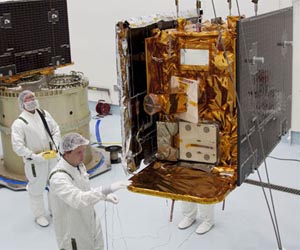The team operating NASA's Curiosity Mars rover is telling the rover to use several tools this weekend to inspect a sandstone slab being evaluated as a possible drilling target.
If this target meets criteria set by engineers and scientists, it could become the mission's third drilled rock, and the first that is not mudstone.
The team calls it "Windjana," after a gorge in Western Australia.
The planned inspection, designed to aid a decision on whether to drill at Windjana, includes observations with the camera and X-ray spectrometer at the end of the rover's arm, use of a brush to remove dust from a patch on the rock, and readings of composition at various points on the rock with an instrument that fires laser shots from the rover's mast.
Curiosity's hammering drill collects powdered sample material from the interior of a rock, and then the rover prepares and delivers portions of the sample to onboard laboratory instruments.
The first two Martian rocks drilled and analyzed this way were mudstone slabs neighboring each other in Yellowknife Bay, about 2.5 miles (4 kilometers) northeast of the rover's current location at a waypoint called "the Kimberley."
Those two rocks yielded evidence of an ancient lakebed environment with key chemical elements and a chemical energy source that provided conditions billions of years ago favourable for microbial life.
From planned drilling at Windjana or some nearby location on sandstone at the Kimberley, Curiosity's science team hopes to analyze the cement that holds together the sand-size grains in the rock.
"We want to learn more about the wet process that turned sand deposits into sandstone here," said Curiosity Project Scientist John Grotzinger, of the California Institute of Technology in Pasadena.
"What was the composition of the fluids that bound the grains together?
That aqueous chemistry is part of the habitability story we're investigating."
The view is an excerpt from an April 11, 2014, observation by the High Resolution Imaging Science Experiment (HiRISE) camera on NASA's Mars Reconnaissance Orbiter.
A larger scene from the same observation can be found here.
In the image's enhanced colour, Curiosity itself appears as the bright blue object at the two-o'clock position relative to the butte in the lower center of the scene.
That butte is called "Mount Remarkable" and stands about 16 feet (5 meters) high.
The rover subsequently drove to within its robotic arm's reach of Windjana. For scale, the distance between the parallel wheel tracks visible in the image is about 9 feet (2.7 meters).
If this target meets criteria set by engineers and scientists, it could become the mission's third drilled rock, and the first that is not mudstone.
The team calls it "Windjana," after a gorge in Western Australia.
The planned inspection, designed to aid a decision on whether to drill at Windjana, includes observations with the camera and X-ray spectrometer at the end of the rover's arm, use of a brush to remove dust from a patch on the rock, and readings of composition at various points on the rock with an instrument that fires laser shots from the rover's mast.
Curiosity's hammering drill collects powdered sample material from the interior of a rock, and then the rover prepares and delivers portions of the sample to onboard laboratory instruments.
The first two Martian rocks drilled and analyzed this way were mudstone slabs neighboring each other in Yellowknife Bay, about 2.5 miles (4 kilometers) northeast of the rover's current location at a waypoint called "the Kimberley."
Those two rocks yielded evidence of an ancient lakebed environment with key chemical elements and a chemical energy source that provided conditions billions of years ago favourable for microbial life.
From planned drilling at Windjana or some nearby location on sandstone at the Kimberley, Curiosity's science team hopes to analyze the cement that holds together the sand-size grains in the rock.
"We want to learn more about the wet process that turned sand deposits into sandstone here," said Curiosity Project Scientist John Grotzinger, of the California Institute of Technology in Pasadena.
"What was the composition of the fluids that bound the grains together?
That aqueous chemistry is part of the habitability story we're investigating."
The view is an excerpt from an April 11, 2014, observation by the High Resolution Imaging Science Experiment (HiRISE) camera on NASA's Mars Reconnaissance Orbiter.
A larger scene from the same observation can be found here.
In the image's enhanced colour, Curiosity itself appears as the bright blue object at the two-o'clock position relative to the butte in the lower center of the scene.
That butte is called "Mount Remarkable" and stands about 16 feet (5 meters) high.
The rover subsequently drove to within its robotic arm's reach of Windjana. For scale, the distance between the parallel wheel tracks visible in the image is about 9 feet (2.7 meters).








 At Astrotech Space Operation's payload processing facility in Titusville, Fla., NASA's Gravity Recovery and Interior Laboratory-A (GRAIL-A) lunar probe is lifted from its workstand and across the clean room toward the spacecraft adapter ring, at left, where GRAIL-B is already secured.
At Astrotech Space Operation's payload processing facility in Titusville, Fla., NASA's Gravity Recovery and Interior Laboratory-A (GRAIL-A) lunar probe is lifted from its workstand and across the clean room toward the spacecraft adapter ring, at left, where GRAIL-B is already secured. 





